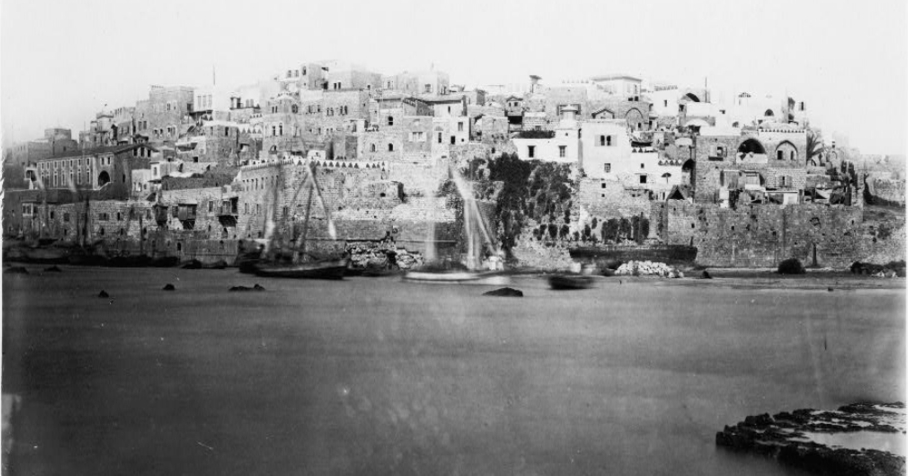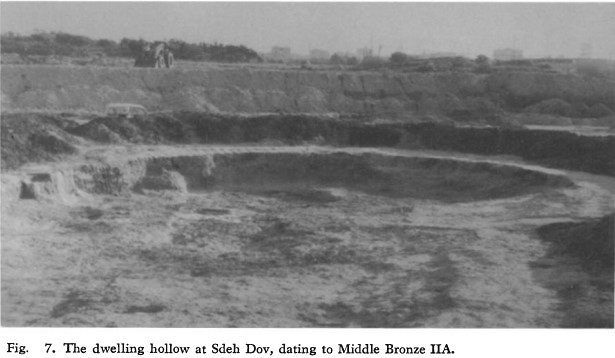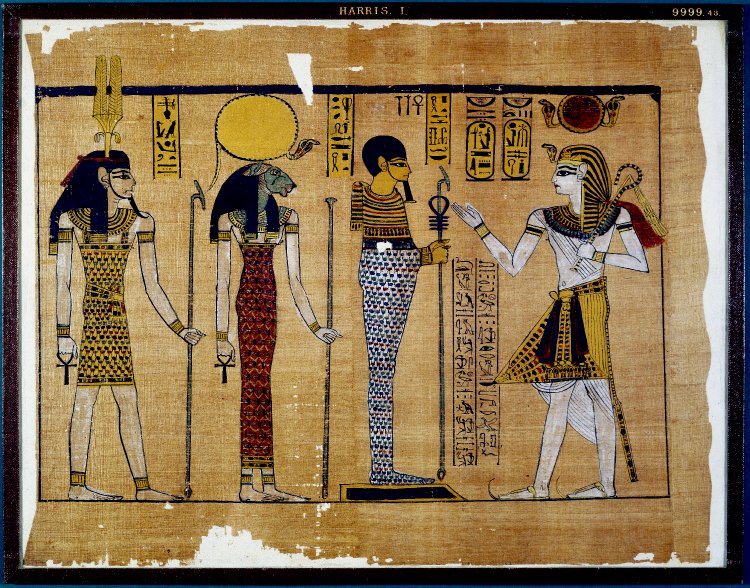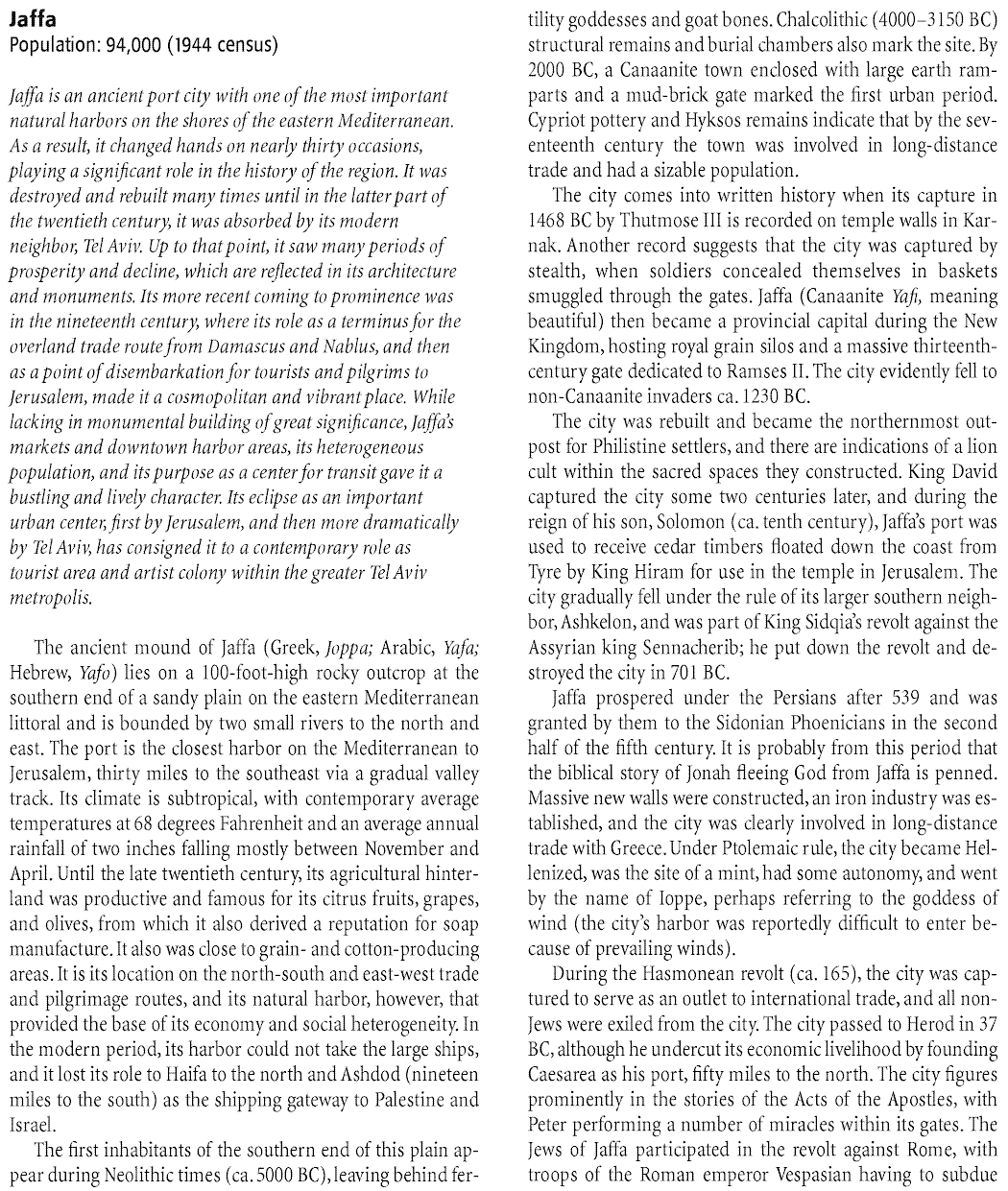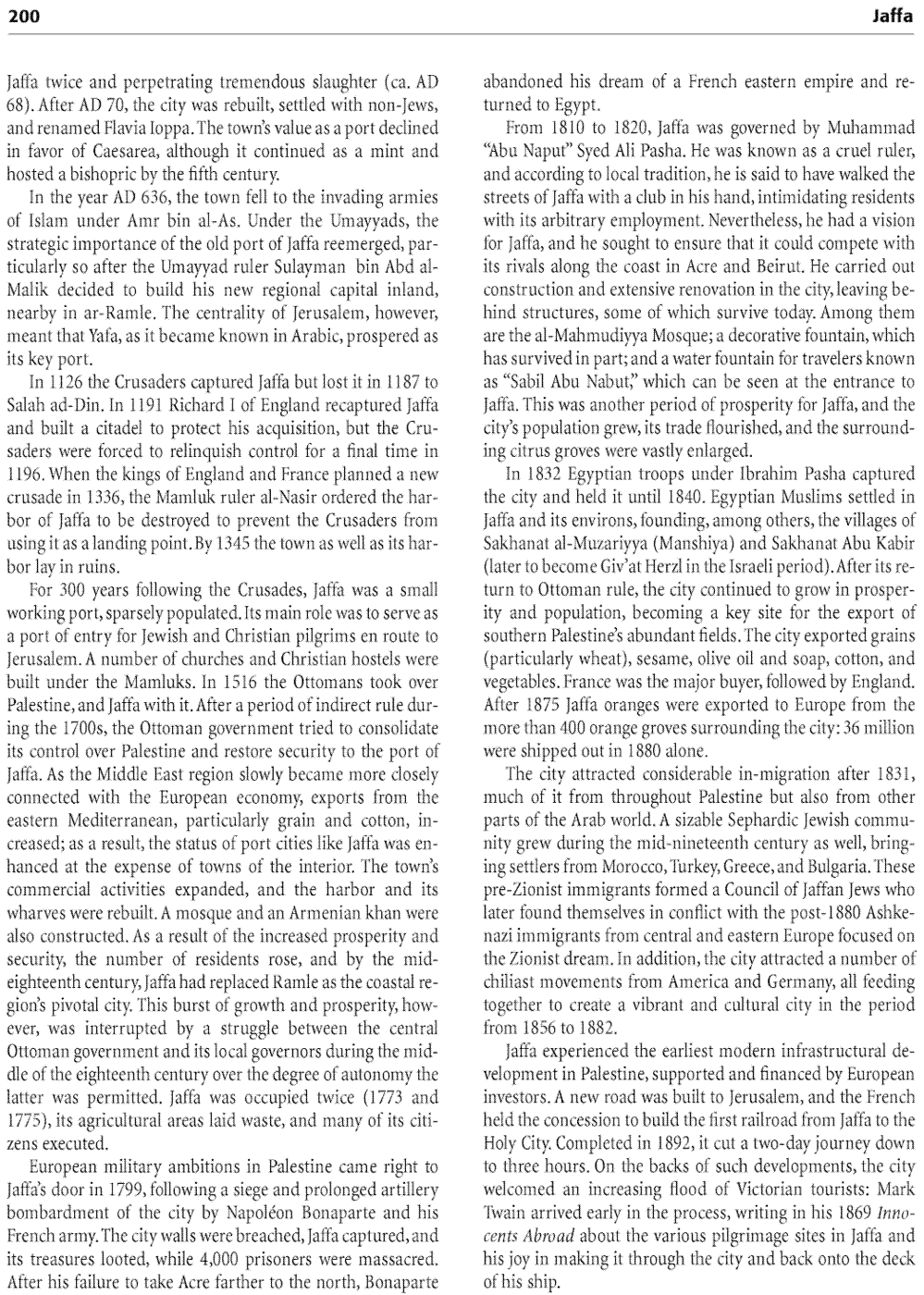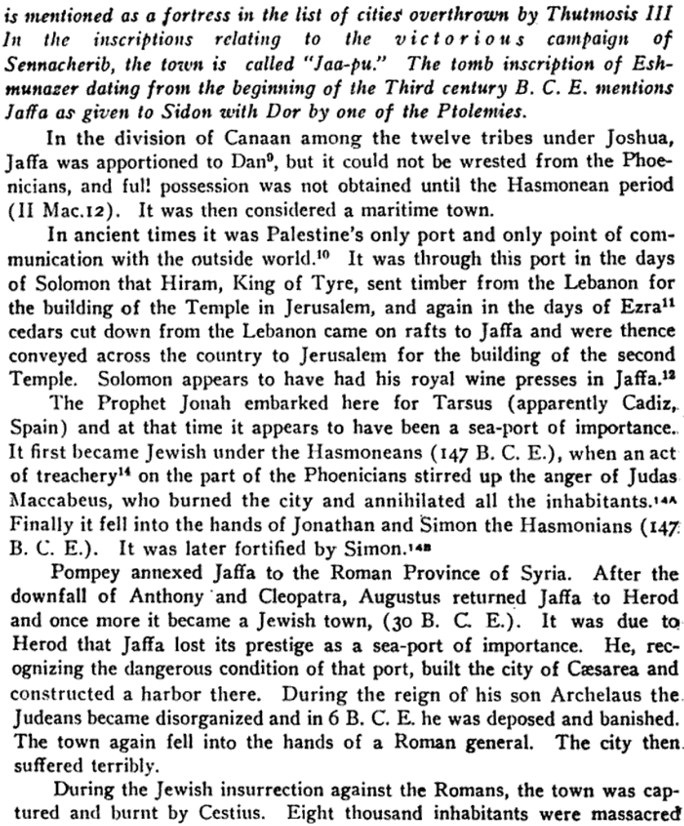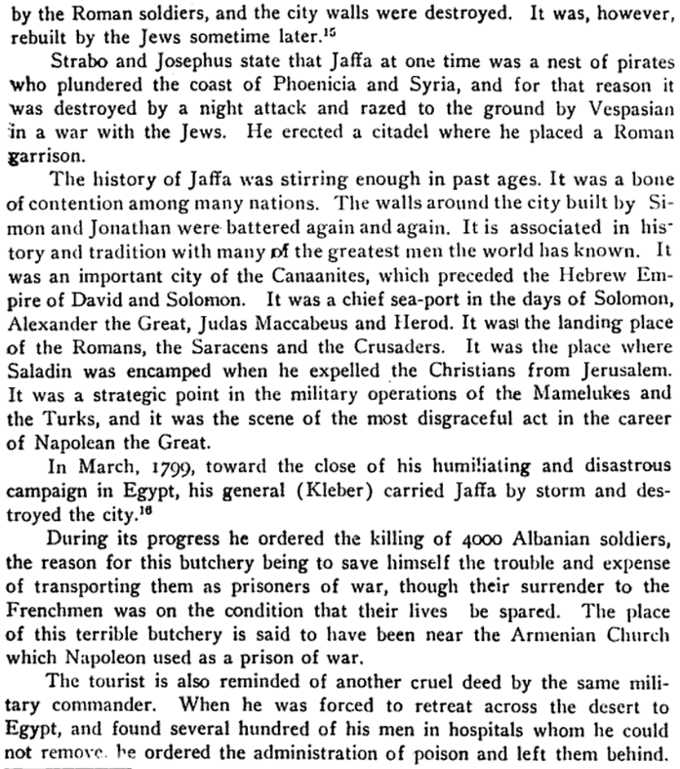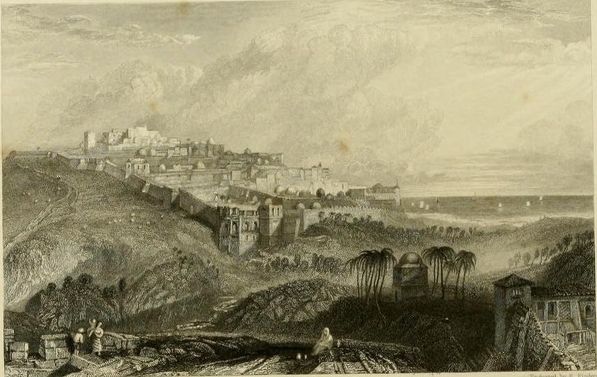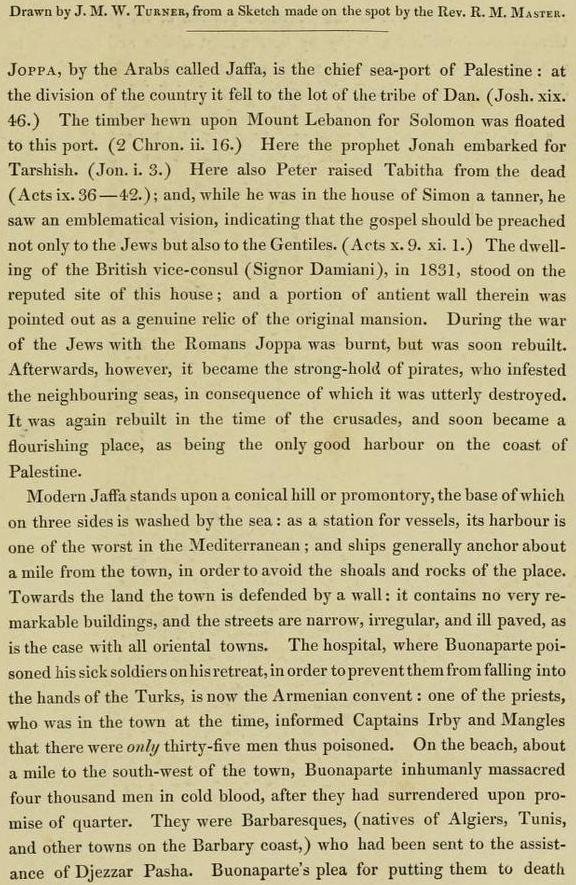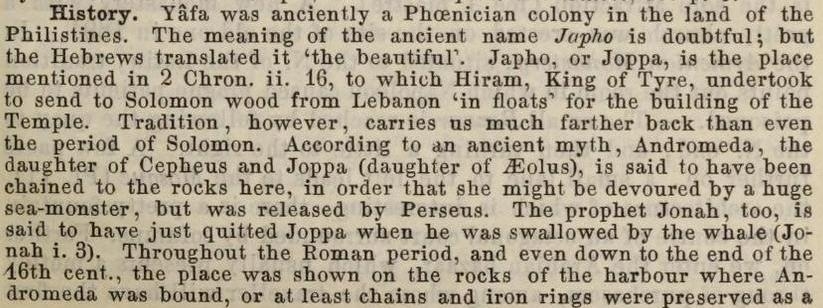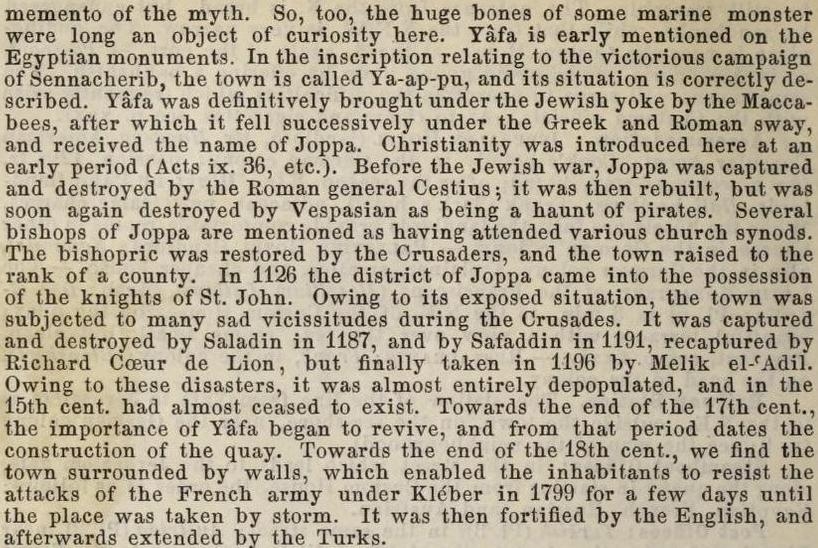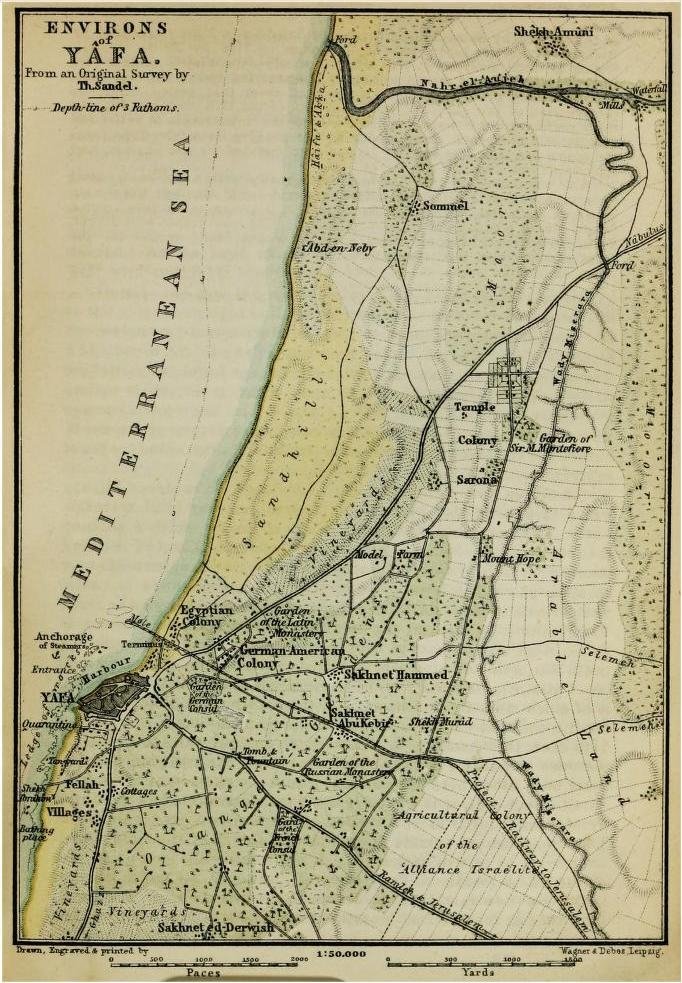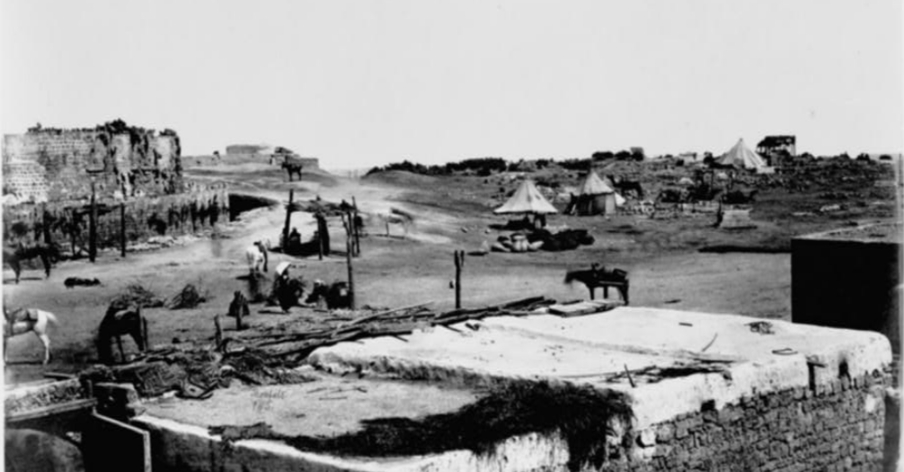|
Other Archaeological Sites / The Neolithic of the Levant (500 Page Book Online) Jaffa -- Tel Aviv -- Hebrew Yapho or Tel Yafo -- Greek Ioppé or Joppa
Joppa in Pages 287-90 of A Handbook for Travellers in Syria and Palestine
Joppa in the Cyclopedia of Biblical -- Theological and Ecclesiastical Literature
SEE the 18 instances of Joppa in Antiquities of the Jews
SEE the 17 instances of Joppa in The Wars of the Jews
JOPPA (Jaffa) Israel in the Princeton Encyclopedia of Classical Sites (1976)
Ezra 3:7 They gave money also unto the masons and to the carpenters; and meat and drink and oil unto them of Zidon and to them of Tyre to bring cedar trees from Lebanon to the sea of Joppa according to the grant that they had of Cyrus King of Persia Etymology: --- The town was mentioned in Egyptian sources and the Amarna letters as Yapu. Mythology says that it is named for Yafet, one of the sons of Noah, the one who built it after the Flood.[1][2] The Hellenist tradition links the name to Iopeia, or Cassiopeia, mother of Andromeda. An outcropping of rocks near the harbor is reputed to have been the place where Andromeda was rescued by Perseus. Pliny the Elder associated the name with Iopa, daughter of Aeolus, god of the wind. The Arab geographer al-Muqaddasi referred to it as Yaffa. (WikiPedia) During the 1950s Yarmukian settlements were discovered at various sites. In 1950-1952 Jacob Kaplan excavated the site of Habashan Street in the midst of the city of Tel Aviv. This site is located 500 metres south of the bank of the Yarkon River in the midst of Tel Aviv. Three seasons of excavations were conducted here by Kaplan between 1950 and 1952 but he only published very short reports. Three occupation layers were unearthed, all without building remains. They were dated as follows (from top to bottom) : Layer I -- Early Bronze ; Layer II -- Wadi Rabah ; Layer III -- Yarmukian. The Yarmukian settlement was established above alluvial virgin soil and the occupation remains consist of some 20 pits. The finds include pottery -- flint objects and figurines, similar to those discovered by Stekelis at Sha'ar HaGolan. The importance of the excavation in Habashan Street is twofold : it enlarges the geographical distribution of the Yarmukian culture to the Coastal Plain and places it stratigraphically below the Wadi Rabah culture (1). According to Jewish tradition Jaffa was first established after the Flood by Japheth (son of Noah) from whom the town took its name. First inhabited in the 18th century BC by the Canaanites it was also a Philistine town later. It is first mentioned in Egyptian sources as one of the cities conquered by Pharaoh Thutmose III in the 15th century B.C. and appears in the list of his conquests in the Temple of Karnak. During the 15th - 13th centuries B.C. it was a fortified town under the hegemony of Egypt. In the Amarna Letters Jaffa is mentioned as an Egyptian fortress. Later King Solomon used the port to bring cedars from Lebanon which were used for the great Temple in Jerusalem. Though King Herod under Roman rule later built Caesarea Maritima to replace Jaffa as his main port it became important again under Moslem and Crusader rule. The town then declined until the 19th century when it began to grow in size and influence ...
(7) The Archaeology and History of Tel Aviv-Jaffa (PDF) by Jacob Kaplan In 1950 an archaeological survey was conducted by the author in the northern area of Tel Aviv, which at that time was still very little built up. This survey found many new sites in the area dating from as early as Neolithic times. Neolithic remains in Tel Aviv (second half of the 5th millennium B.C.) --- The only Neolithic site within the borders of Tel Aviv belongs to the Yarmukian Culture. The site, on a kurkar hill to the south of the Yarkon River, is known as “Rehov ha-Bashan” after the name of the street which runs along its southern base. Their occupation remains comprise layers of ashes, hollows and pits dug out of the soil. Noteworthy was the absence of any stone or mud-brick building remains. This leads one to assume that the settlers erected booths or dug shelter pits which they covered with boughs or animal hides. Much may be learned from these remains about the way of life of the inhabitants of this settlement, who subsisted on hunting and incipient agriculture. Among the implements and weapons found were flint arrow and spearheads, hoes and sickles, grindstones, fragments of stone bowls and pottery storage jars and also bone tools. The Chalcolithic Period (4000-3150 B.C.) This period may be subdivided into two main phases -- an early phase first discovered by the author and called the “Wadi Rabah” culture and a later phase, the well-known “Ghassulian” culture. While the Ghassulian culture has been known since the end of the 1920’s, knowledge of the Wadi Rabah culture dates only from 1950 when it was discovered in ha-Bashan Street at Tel Aviv. However the name “Wadi Rabah” was given to this culture only when the author came across it a second time at the eastern end of the Yarkon basin on the south bank of the Wadi Rabah tributary. This site provided further evidence of the distinctive character of this culture which differs from the Ghassulian. Moreover at Wadi Rabah the Ghassulian remains were exposed above those of the “Wadi Rabah" settlement, which proves that the latter was the earlier culture. Chalcolithic remains in Tel Aviv --- Chalcolithic remains have been found in Tel Aviv at three sites: ha-Bashan Street -- Jabotinsky Street and Abattoir Hill. At ha-Bashan Street the Wadi Rabah remains were bare of structures and partly overlaid the Yarmukian remains. The excavations yielded mainly dwelling floors paved with small stones and strewn with ashes, numerous potsherds, animal bones and flint implements. Characteristic features of the Wadi Rabah ware are the carinated bowls, bow-rimmed jars and black and red burnishing -- none of which are found in the Ghassulian ware. Excavations were conducted here in 1950 -- 1951 and 1961. Three shelter-pits were exposed at the eastern extremity. The first had apparently been used as a kitchen and was filled with ashes, cinders, animal bones and potsherds. Early Bronze Age (3150-2200 B.C.) The beginnings of urbanization in this country fall in the Early Bronze age. The remains of three Early Bronze settlements were discovered in Tel Aviv; two were small temporary settlements dating to EB 1 while the third site belongs to EB IV. The first two settlements were exposed at ha-Bashan Street and Abattoir Hill; both overlay the Chalcolithic remains. The third settlement, at Tell Grisa, came to light in the lowest stratum on top of the bedrock. The remains at ha-Bashan Street -- layers of ashes and segments of small stone pavings but no structures -- apparently belonged to squatter-type settlements like the Neolithic occupation remains beneath. Hearths, potsherds, animal bones and flint implements were found in these remains. Middle Bronze Age (2200-1550 B.C.) Remains from the two main phases of this period -- MB I (2200-2000 B.C.) and MB II (2000-1550 B.C.) -- have been unearthed at numerous sites throughout Tel Aviv-Jaffa. Several MB I sites have been excavated in the Tel Aviv area. At Tell Grisa meager occupation remains were found and elsewhere at Abattoir Hill -- Pinkas Street -- Ramat-Aviv -- Sdeh Dov and Petakh Tikvah Road the remains were shaft-tombs. Some of the tombs were empty but in others were found disintegrated human bones, a few pottery funerary vessels and sundry bronze weapons. In a cave excavated at Ramat ha-Khayil in Tel Aviv an MB IIA burial was found overlying an earlier burial dating to MB I. It may be assumed that the MB IIA people were responsible for the destruction of the MB I culture and apparently made use of the tombs of the former where these could be detected on the surface. The MB II period may be subdivided into three phases; MB IIA, B and C. It seems that during the MB IIA phase (2000-1800 BC) the western Semites-Amorites migrated in waves from Mesopotamia to Palestine, bringing small groups of permanent settlers who established new religious centers and strongholds. Simultaneously or perhaps somewhat earlier, hordes of semi-nomads together with their families and animals reached this country where they built for defensive purposes beaten-earth rampart enclosures covering hundreds of acres. Apparently two cities were built during this period, one at Jaffa and the other at Tell Grisa. The eastern sector of the tell of Jaffa with its prominent and still visible slope is actually part of an enormous earth rampart. It would appear that this rampart is but one side of the square enclosure which was the original [Canaanite] Jaffa. Pottery dating to MB IIA was found at Jaffa though its connection with the rampart has not been classified. Nevertheless, the finding of this pottery allows one to surmise that the enclosure -- the first Jaffa -- was perhaps built during the MB IIA period. At Tell Grisa also MB IIA pottery was found but as at Jaffa its connection with the wall is not clear except perhaps for the glacis which by its excavators is dated to MB IIB. A discovery unique in the context of Near Eastern archaeology was made in Tel Aviv near the Sdeh Dov airport, namely the occupation remains of a semi-nomadic shepherd clan. If so far hardly any of this type of site has been excavated, the reason must be sought primarily in the archaeologists’ preference for the mound of impressive size or storied name. The occupation remains of these sites are generally found in hollows, pits and graves, with no impressive structures above the surface. Since the 1950’s much has been accomplished in Israel in the investigation of these semi-nomad settlements though mainly with regard to the Neolithic and Chalcolithic periods. Very little is known about the material culture of these semi-nomadic shepherds from Mesopotamia, Anatolia and Syria other than that revealed in written documents; hence the importance of an excavation of the type at Sdeh Dov.
The hollow at Sdeh Dov was used intermittently for the purpose of dwelling as has been the custom of semi-nomadic shepherd societies everywhere. It may be surmised that here also the dwelling area was covered entirely or in part with goat-hair tents or animal hides as is still done by the Bedouin today. Apart from numerous MB IIA pottery fragments the bones of goats, sheep, cattle and the skull of a donkey were identified. Also among the oven-ashes were found carbonized grains of barley and other cereals. This entire group of finds may be related to one clan, apparently from among the Amorite tribes who had settled in this country during the MBII period. In the MB IIB period the kingdoms of Mesopotamia, Syria, Palestine and Egypt were all ruled by Western Semites. The Western-Semitic dynasty which rose to power in Egypt was called by the Egyptians “Hyksos” (“rulers from foreign lands"). The Hyksos erected numerous fortified cities in Palestine and Syria and occupied most of the fertile regions. Palestine served as a land bridge for international trade and Egyptian luxury items found their way to this country as has been demonstrated by the excavations of the remains of cities and tombs of this period. At Tell Grisa part of a Hyksos city and fortifications were excavated. One of the upper strata of the mound contained the foundations of a large building and in a lower stratum was found a large pottery kiln. The city, built on top of a natural kurkar hill, was surrounded by a defensive mud-brick wall from the base of which a glacis extended to the bottom of the hill. This glacis was constructed of alternate layers of beaten earth and mud brick topped by a lining of crushed kurkar.
The remains of an unfortified settlement discovered in the section of Abattoir Hill called General Hill Square may be dated to this period. The site was apparently an estate or small village owned by a Hyksos notable who resided either in Jalfa or Tell Grisa. Several graves were uncovered; one in the upper layers of a Chalcolithic burial cave contained the skeleton of a man and nearby that of a donkey. Here also two kilns were found -- the smaller one at General Hill Square and the second in the area of the Chalcolithic settlement on the eastern slope of the hill. Inside both kilns were found pottery vessels which had already been fired. The fact that many kilns have been found at the Tel Aviv-Jaffa MB II sites indicates that there must have been a very large demand for pottery vessels in this period. This suggests a high population density which is confirmed by the MB II remains found at other sites in the country. The MB IIC period is noteworthy for the first trading contacts with Cyprus. From this period on Cypriote pottery (imported for the next thousand years and found at every local site) provides tangible evidence for trade relations between this country and the neighboring island. At Jaffa the remains of this phase were exposed in the strata around the Hyksos fortress as well as in the area opposite St. Peter's Church and in a trial pit west of the fortress. Details of this phase are lacking at Tell Grisa and it is not clear whether the mound was then occupied. On the other hand MB IIC occupation remains were exposed at the Abattoir Hill during the 1970 excavations. The Late Bronze Age (1550-1200 B.C.) The Late Bronze age may be divided into two phases: Phase I (1550-1400 B.C.) and Phase II (1400-1200 B.C.). The fifty years from 1550 to 1500 were most eventful and may be regarded as a transitional phase between the MB and LB periods. The expulsion of the Hyksos from Egypt was completed around 1570 B.C. by the early rulers of the 18th Dynasty who then set out on their campaigns of conquest. The local city governors, who were predominantly Hurrians, began to fortify their cities in anticipation of the future struggle against Egypt. The glacis was now lined with stones on the outside while the mud-brick walls became more massive, their lower sections formed of Cyclopean stones. A unique pottery, notable for its red and grey-black bichrome decoration, makes its appearance. Apart from geometric patterns one finds decorations of animals, birds and fish. By some people this pottery is linked with the Hurrian element in the country but it should be noted that as it spread so also the MB II forms continued to appear. This bichrome pottery was found at all the three local sites -- Jaffa, Tell Grisa and Abattoir Hill ... Thutmoses I had the names of all the conquered cities of Canaan and Syria engraved on the walls of his temple at Karnak in Upper Egypt. Among these names appear Jaffa and its neighbor Gimtu. The conquest of Jaffa by Thutmoses is mentioned in a folk-tale of the well-known “Harris Papyrus” where it is related that the city was taken not by a frontal assault but by a trick reminiscent of the capture of Troy -- the soldiers of the attacking force were concealed in baskets and smuggled into the citadel. At any rate Egyptian documents mentioning Jaffa begin to appear from the 15th century onwards and the information they contain gains added importance when joined to that revealed in the excavations.
The 14th century B.C. is known as the "Amarna Age" after the site in Egypt where the remains of the palace of king Akhnaton were discovered. Within these remains were found hundreds of clay tablets inscribed in Akkadian -- letters dispatched by Egyptian officials and city governors in Canaan to their lord the king of Egypt. These letters inform us about the political situation of the time. From one of the two letters which deal directly with Jaffa the late W. F. Albright concluded that the king of Egypt maintained royal granaries in the city, which implies that Jaffa was the next important supply depot after Gaza on the land and sea route northward to Syria and Mesopotamia. Of the remains from this period excavated by the author at Jaffa, noteworthy are floor and wall segments found in the Hyksos citadel area. Among other things a stone-built silo was unearthed which contained many vessels typical of this period. At Tell Grisa were found mainly burials while at Abattoir Hill only meager remains were excavated. The 13th century is the period of Rameses II who at the beginning of his reign launched a military campaign against the Hittites in northern Syria. When the battle was joined near Kadesh on the Orontes (1274 B.C.) it reached a stalemate because of the evenly matched strength of the two armies. Thereafter an agreement was signed between the two kings which defined respective spheres of influence. At the eastern section of the Hyksos citadel at Jaffa the lower portion of a new gateway was exposed having the names and titles of Rameses on its stone jambs. We may assume that this gateway was erected to honor his "triumphant" return to Egypt after his battle against the Hittites. The entrance of the gateway is 4.0 meters or about fourteen feet wide; the road leading from the gate into the citadel passed between two mudbrick walls 18 meters (60 feet) long which supported the stairs to the roof where the defenders were stationed. Gateways of this type may be seen in Egyptian reliefs depicting the conquest of Canaanite cities. The Ramesside gateway and citadel was destroyed in a severe conflagration which not only burnt the wooden gate but also disintegrated the mudbricks of the entrance walls which toppled inwards and covered the road. The date of destruction of the Rameses citadel and the identity of the attackers are two questions which require clarification. It may be assumed that the destruction happened near the end of Rameses' reign in the third quarter of the 13th century B.C. when his power was on the wane. The conquest of the Canaanite cities by Joshua is generally attributed to this period though neither Jaffa nor any of the other coastal cities appear in the lists of conquests. Gezer, some eighteen miles southeast of Jaffa, is the nearest city listed. The more likely explanation is therefore that the attackers were the "Sea Peoples" who had infiltrated and occupied the Jaffa area. The Rameses gateway was assigned to Stratum V in the stratigraphy of this area. Above the ruins of the gateway threshold, at a height of some six and one-half feet, a new gateway was erected which we assigned to Stratum IV. The fire-damaged brick walls of Stratum IV had been repaired with bricks containing broken pottery from the earlier phase; this implies that the raw material for these bricks had been taken from the soil nearby in the city unlike the bricks of the Rameses gateway which were made of reddish-yellow hamra free of potsherds. Gateway IV also had been destroyed by a severe fire and the bronze hinge of its wooden gate lay among the fire-reddened debris. It is difficult to estimate how long the inhabitants of Stratum IV were allowed to live in peace before their city too was destroyed. Yet this second destruction might well have been carried out by Merneptah (son of Rameses II) who, as recorded on his victory stele, undertook a punitive expedition about 1230 B.C. when he conquered a number of towns including Gezer and Ashkelon. Thus the second destruction of Jaffa, which in this period was probably under the rule of the "Sea Peoples", seems to have been a further stage in the campaign of Merneptah against the Lybian-Sea Peoples coalition that was threatening Egypt. Turning now to Tell Grisa we find there is no other information than that supplied by the excavators, namely that the settlement was destroyed around 1200 B.C. by either the Sea Peoples or the Israelites. Abattoir Hill it seems was completely deserted in this period. Israelite Period (1200-586 B.C.) This period may be divided into two phases; the first 1200-1000 B.C., the age of the Judges and the second 1000-586 B.C., the Judean and Israelite monarchies. There are no documents from the first phase relating to Jaffa although the passage in the book of Joshua giving the borders of the tribe of Dan contains a reference to the town (Joshua 19:46). This description of the border of Dan is thought by scholars to refer to the period of David, i.e. the early 10th century B.C. At first glance there seems to be no evidence in this passage to suggest that the tribe of Dan was settled on the coast during the first phase. Yet if one goes by the Song of Deborah, which has been ascribed to the 13th or 12th centuries B.C. (Judges 5:17), it becomes plausible that these verses refer to an earlier situation when Dan's inheritance included the Jaffa area up to the coastline. We shall now attempt to clarify what happened in the area of Jaffa Gateway IV after its destruction by Merneptah in 1230 B.C. This area of the destroyed gateway was covered by a glacis constructed of bricks and stones dating to the end of the 12th century B.C. which corresponds to Stratum XI at Tell Qasile. It appears that after the destruction of Stratum IV this area ceased to serve its former purpose -- that is no further gateways were built at this spot. Also, west of the entrance walls of Gateway IV there was discovered an occupation phase of which the remains were a narrow strip of ashes and a pit filled with ashes and Philistine potsherds corresponding in date to Stratum XI at Tell Qasile. It may thus be concluded that there was a gap in the occupation of the early gateway area between 1230-1120 B.C. However this is not the case in the western citadel area which was excavated in the 1970 and 1971 seasons. Here two distinct occupation phases were uncovered beneath layers of ashes, corresponding in date to Strata XI-X at Tell Qasile. ... Thus we may assume that there was no great lapse in time after the destruction by Merneptah in 1230 B.C. until the arrival of the new settlers who were also from among the Sea-Peoples, perhaps from among the Danuna, who rebuilt the palace and temple. The newcomers apparently continued in occupation till the arrival of the Philistines in the coastal region which coincides with the founding of the settlement in Stratum XII at Tell Qasile (circa 1175 B.C.). It is not clear from the Tell Grisa excavations whether any pre-Philistine strata are present there while none are found at Tell Qasile. This applies also to Abattoir Hill where no Early Iron age remains turned up. The later part of the period of the Judges, which corresponds in date to Stratum X at Tell Qasile, was called by Professor Mazar the post-Philistine phase. This phase is represented at Jaffa by only meager remains. It is possible that the more substantial remains were destroyed by building operations in subsequent periods. However one cannot escape the impression that the main center of population during this time shifted to the Yarkon basin where the remains from Tell Qasile and Tell Grisa point to an era of prosperity and the development of commercial relations with Phoenicia and Egypt. The Yarkon river served as a safe waterway to the towns near its banks. The settlement in Stratum X of Tell Qasile, and the corresponding settlement at Tell Grisa, were burned to the ground apparently by King David who, as we know, vanquished the "Philistines". It seems that after this destruction the settlement at Tell Grisa was not rebuilt. Israelite Period II Except for the evidence from Tell Qasile there are very few archaeological data on the Jaffa area in this period. Only in the latter third of the 8th century B.C. do Jaffa and Abattoir Hill figure again in the historical record, this time in connection with the military campaigns of the Assyrian kings. Stratum IX at Tell Qasile dates to the period of David and Solomon, i.e. the 10th century B.C., and Stratum VIII of the same tell belongs to the 9th century, the time of the House of Omri, during which the town flourished and expanded and a fort was built on the north bank of the Yarkon estuary to keep guard over the sea trade entering the river. The fort, constructed of large ashlars, is reminiscent of the building style of the period of King Ahab. Stratum VII at Tell Qasile, which dates to the 8th century B.C., embraces the period of the royal house of Jehu as well as the final phase of the northern kingdom. The last Israelite settlement at Tell Qasile was probably destroyed in 732 B.C. by Tiglath Pileser III ... In 722 B.C. Sargon II of Assyria conquered Samaria, the capital of the kindom of Israel, and exiled its inhabitants, replacing them with a new population; his son Sennacherib launched in 701 B.C. a campaign against the kingdoms of Judea and Ashkelon which were supported by Egypt. On his way to battle against the coalition of hostile states opposing him he conquered Jaffa, Azor, Beth-dagon and Bnei-Braq -- all cities of Sidqia, king of Ashkelon. It may perhaps be inferred from this that the coalition had fortified a number of cities along the River Ajalon. Interestingly, remains from this period were discovered by the author in the northern sector of Abattoir Hill. The site, which shows signs of destruction by fire, was perhaps connected with this campaign. At Jaffa, during excavations carried out in the "Hamam" building which abuts the southern end of the museum, there was exposed a glacis with its slope oriented west-east. This glacis was built on top of the earlier Middle Bronze II glacis. Beneath the surface of the later glacis were revealed layers of mud-bricks mixed with pottery from the end of the 8th century B.C. A similar glacis, discovered by the author at Ashdod-Yam, dates from this period. The Persian Period-Return of the Exiles (539-333 B.C.) The Babylonian empire was conquered in 539 B.C. by Cyrus, king of Persia, who permitted the Jewish exiles to return to Jerusalem and rebuild it from its ruins. In 515 B.C. Zerubbabel completed the rebuilding of the Second Temple. As in Solomon's time the cedars used in its construction were brought from the Lebanon to the "sea of Joppa" (II Chronicles 2:16). The remains of the Persian period at Jaffa bear witness to economic prosperity and expansion, especially from the second half of the 5th century B.C. onwards when it became a Phoenician city. We know about the Phoenician occupation from two sources -- one the inscription on the sarcophagus of the Sidonian king Eshmunazar which records that he received from the Lord of Kings (king of Persia) the two harbor cities Jaffa and Dor; and the second a description of the coastal cities of Syria and Palestine written during the first half of the 4th century B.C. but attributed to Scylax, a seafarer who lived during the 5th century. Some ascribe the story of Jonah, the prophet who attempted to flee the Lord via Jaffa to Tarshish, to this period (Jonah 1:3). Although Jaffa contains many remains from the Persian period the structural remnants are generally connected with the Sidonian rule. The Sidonians surrounded the city with a stone wall eight feet thick. The walls of their buildings were constructed by a method specific to this period: pillars of ashlar stones were erected five or six feet apart and the spaces between them filled in with rubble stones. During the 1970-1971 excavations were exposed two segments of a large building which appears to have been a temple. Jaffa was linked in trade with every country of the Mediterranean and the many fragments of Greek pottery found attest a large import of decorated Attic ware. Remains found in a number of places indicate the existence of an iron founder industry. Hellenistic and Hasmonean Periods (332-37 B.C.) Following the death of Alexander the Great in 332 B.C. civil war broke out between his successors. After its conclusion in about 300 B.C. the countries on the eastern Mediterranean seaboard were divided up between the two rival generals who founded dynasties -- the Ptolemaic whose capital was at Alexandria and the Seleucid with its center at Antioch in Syria. The border between the two states passes near the northern frontier of Israel today. Jaffa became the seat of government and trade of the area. During the rule of Ptolemy II Philadelphus (261-246 B.C.) and of Ptolemy III there was a mint in Jaffa which issued its own coins. To all intents and purposes Jaffa had become a Greek city and even its name made to be Greek-sounding (Ioppe). Jaffa appears in the papyri of Zenon, the emissary of the Ptolemaic minister of finance, who visited the country around 250 B.C. and mentions that the city is now an independent port no longer under Phoenician rule. The principal remains of this period excavated by the author in Jaffa are in the area opposite St. Peter's Church where part of a large building -- a complex of small interconnected rooms reminiscent of the Hellenistic Agora buildings -- was unearthed. Another structure of this period exposed in Area C is a catacomb comprising a courtyard and three halls built into the hill slope facing west. Among the debris in the courtyard was found a marble slab inscribed in Greek. The inscription on the slab is dedicated to Ptolemy IV (Philopater). After nearly a century of struggle between the Ptolemaic and Seleucid dynasties the country about 200 B.C. passed into the hands of the Seleucids. The Hasmonean revolt which erupted in 167 B.C. was aimed as much against the Hellenization of the upper classes of the Jewish population of Judea as against the anti-Jewish legislation of Antiochus IV. The handful of rebels, under the leadership of the priest Matthias and his sons, who were faithful to the traditions of Ezra and Nehemiah, grew ever more successful until the war for religious freedom became a war of national liberation. Judea, which had no outlet to the sea, was at the mercy of foreign authorities who imposed custom duties on everything that passed through the port of Jaffa. The foremost aim of the rebels was to capture the city, which Jonathan soon accomplished, though subsequently it changed hands again until Jaffa was finally annexed by Simon to Judea. All foreigners were then expelled and soldiers of Simon's army settled in the city. John Hyrcanus was the first subsequently to conquer the Yarkon basin and the ports to the north and south of Jaffa. Finally with the support of the Roman Senate he succeeded in annulling the claims of the Syrian kings for the return of Jaffa and the payment of war reparations resulting from the conquest. The Herodian Period and the End of the Second Temple (37 B.C.- A.D. 70) Herod achieved his aim to succeed the Hasmonean dynasty when following his capture of Jerusalem he put Antigonus to death. Ascending the throne in 37 B.C. he immediately began to earn himself renown as a builder of cities and magnificent edifices. He founded Caesarea, a new port between Acre and Jaffa. The building of this rival port was among other things a blow aimed at the Jews of Jaffa who had remained loyal to the Hasmoneans. When the Jewish war against Rome broke out the Jews of Jaffa joined the revolt but punishment was swiftly meted out. Cestius Gallus, the Syrian legate, on his way to capture Jerusalem turned first on Jaffa and slaughtered many of its inhabitants. However after he had come to grief before Jerusalem and returned defeated to Caesarea, the revolt in Jaffa was renewed by the insurgents who built there a naval base which interfered with the Roman shipping and caused it much damage. Accordingly the first act of Vespasian following his conquest of Galilee was to return and smite Jaffa after which he stationed cavalry on the hill and then spread out among the nearby towns and villages, which were razed to the ground. Remains of this period were found at Tell Qasile -- Ramat ha-Khayil near Tel Barukh and Jabotinsky Street near the Herzlia High School -- all village-type settlements near which rock-hewn tombs were found. From these tombs were recovered fragments of stone ossuaries with rosette decorations such as are found on the well-known ossuaries from Jerusalem. The Roman-Byzantine Period (A.D. 70-640) After Jaffa's destruction by the army of Vespasian the city was resettled by gentiles and named Flavia Ioppa in honor of Vespasian. This name continued in use even during the reign of Elagabalus (A.D. 218-222) as is attested by coins apparently minted at Jaffa during this period. Jaffa is mentioned in the Mishna and Talmud in connection with halachic rulings handed down by its rabbinical scholars. At Jaffa the principal remains of this period were found in Area C above the Hellenistic catacomb and above the remains of the 1st century house destroyed during the campaign of Cestius Gallus. The house was assigned to Stratum VI in the stratigraphy of Area C. Stratum V is datable to the rule of Trajan while Stratum IV may be dated to the period of Elagabalus; the remaining strata I-III are Byzantine (A.D. 324-640). At Tel Aviv the majority of the occupation remains of the Roman-Byzantine period were found north of the Yarkon river. Strata IV-VI, assigned to this period, included many structural remains ...
Of the greatest interest is the Jewish cemetery excavated by the author in 1951-52 and 1968 at Tell Barukh. Here eight small tomb complexes dating from the 3rd century A.D. to the Arab period were uncovered. The excavations yielded a large quantity of glass and pottery vessels as well as ornaments of bronze and iron. The burial caves were hewn in the rock and their entrances sealed by a rolling stone which on its narrow side fitted into a recess. A bronze amulet bearing a Samaritan inscription was found in one of the tombs. The inscription comprises parts of verses from the Pentateuch as commonly found in Samaritan inscriptions. The finding of this amulet makes it probable that one of the two ancient sites near the cemetery was inhabited by Samaritans. Another Samaritan amulet was unearthed by the author in 1964 at Ramat ha-Khayil -- again a site north of the Yarkon river. Unfortunately the names of the ancient villages to which these two cemeteries belonged have not been preserved. On the other hand we know from literary sources of three other sites in the Yarkon basin that they were inhabited by Samaritans during the Byzantine period. Thus we get an almost complete picture of the Samaritan settlement in the southern Sharon Plain during the 4th and 5th centuries A.D. ...
(6) Cities of the Middle East and North Africa: A Historical Encyclopedia
(2) New Judea: Jewish Life in Modern Palestine and Egypt by Benjamin Lee Gordon (1919)
(3) Landscape Illustrations of the Bible --- Publisher : John Murray (1836)
(4) Palestine and Syria : handbook for travellers --- Karl Baedeker (Publisher)
1876 1894 1898 1906 1912
(5) Page 286 in Early travels in Palestine by Thomas Wright (1848)
The Travels of Bertrandon de La Brocq́uière to Palestine --- Translated by Thomas Johnes (1807) ...
Bibliography for Jaffa (368 Listings) --- Prepared by Aaron A. Burke (2013) (1) The Yarmukian Culture in Israel by Yosef Garfinkel in Paléorient Année 1993 / Volume 19 N°1 / Pages 115-134 (2) New Judea: Jewish Life in Modern Palestine and Egypt by Benjamin Lee Gordon (1919) (3) Landscape Illustrations of the Bible --- Publisher : John Murray (1836) (4) Palestine and Syria : handbook for travellers --- Karl Baedeker (Publisher) 1876 1894 1898 1906 1912 (5) The Travels of Bertrandon de La Brocq́uière to Palestine --- Translated by Thomas Johnes (1807) (6) Cities of the Middle East and North Africa: A Historical Encyclopedia --- Edited by Michael Dumper and Bruce E. Stanley (2007)
(7) The Archaeology and History of Tel Aviv-Jaffa (PDF) by Jacob Kaplan Joppa in Eerdmans Dictionary of the Bible Edited by David Noel Freedman and Allen C. Myers (2000) |
